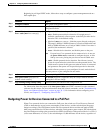
12-25
Catalyst 2960 and 2960-S Switch Software Configuration Guide
OL-8603-09
Chapter 12 Configuring Interface Characteristics
Configuring Ethernet Interfaces
Setting the Type of a Dual-Purpose Uplink Port
Note Only Catalyst 2960 switches have dual-purpose uplinks ports.
Some switches support dual-purpose uplink ports. By default, the switch dynamically selects the
interface type that first links up. However, you can use the media-type interface configuration command
to manually select the RJ-45 connector or the SFP module connector. For more information, see the
“Dual-Purpose Uplink Ports” section on page 12-4.
Beginning in privileged EXEC mode, follow these steps to select which dual-purpose uplink to activate so
that you can set the speed and duplex. This procedure is optional.
Command Purpose
Step 1
configure terminal Enter global configuration mode.
Step 2
interface interface-id Specify the dual-purpose uplink port to be configured, and enter
interface configuration mode.
Step 3
media-type {auto-select | rj45 | sfp} Select the interface and type of a dual-purpose uplink port. The
keywords have these meanings:
• auto-select—The switch dynamically selects the type. When link
up is achieved, the switch disables the other type until the active
link goes down. When the active link goes down, the switch
enables both types until one of them links up. In auto-select
mode, the switch configures both types with autonegotiation of
speed and duplex (the default). Depending on the type of installed
SFP module, the switch might not be able to dynamically select
it. For more information, see the information that follows this
procedure.
• rj45—The switch disables the SFP module interface. If you
connect an SFP module to this port, it cannot attain a link even if
the RJ-45 side is down or is not connected. In this mode, the
dual-purpose port behaves like a 10/100/1000BASE-TX
interface. You can configure the speed and duplex settings
consistent with this interface type.
• sfp—The switch disables the RJ-45 interface. If you connect a
cable to the RJ-45 port, it cannot attain a link even if the SFP
module side is down or if the SFP module is not present. Based
on the type of installed SFP module, you can configure the speed
and duplex settings consistent with this interface type.
For information about setting the speed and duplex, see the “Speed
and Duplex Configuration Guidelines” section on page 12-26.
Step 4
end Return to privileged EXEC mode.
Step 5
show interfaces interface-id transceiver
properties
Verify your setting.
Step 6
copy running-config startup-config (Optional) Save your entries in the configuration file.


















